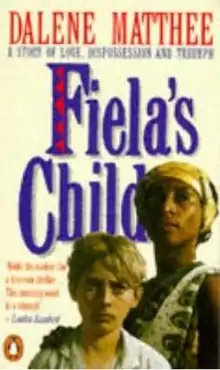 | |
| Author | Dalene Matthee |
|---|---|
| Original title | Fiela se Kind |
| Country | South Africa |
| Language | Afrikaans |
| Genre | Drama |
| Publisher | Tafelberg Publishers Ltd |
Publication date | 1985 |
Published in English | 1986 |
| Media type | Hardcover/Movie |
| Pages | 314 |
| ISBN | 0-394-55231-8 |
| OCLC | 13003348 |
| 823 19 | |
| LC Class | PR9369.3.M376 F5 1986 |
Fiela's Child is a South African drama written by Dalene Matthee and published in 1985. The book was originally written in Afrikaans under the name Fiela se Kind, and was later translated into English, German, French, Hebrew, Dutch, Slovene and Swedish.[1]
Plot
The story is set in the forests of Knysna, South Africa in the nineteenth century, and tells the story of a Cape Coloured woman, Fiela Komoetie, and her family who adopts an abandoned Afrikaner child Benjamin Komoetie at tender age of three found outside her door. Nine years later, census-takers come to count the people living in the Long Kloof. They are shocked that a white child is living with a Coloured family and somehow come to the conclusion that the white child must be the child lost by the van Rooyens who live in the Forest. Fiela is distraught that her child is being taken away and travels to speak with the magistrate which fails because the magistrate is a white supremacist. The magistrate warns Fiela that if she interferes any more she will be dealt with. The child is taken away from her and forced to live with the van Rooyens who make beams from wood. His living conditions with the white people are much worse than with his Coloured family. Elias van Rooyen continuously abuses the family and everyone is thoroughly miserable. The child, Benjamin Komoetie, is forced to take up the name of Lukas van Rooyen and falls in love with his apparent sister, Nina van Rooyen. The climax of the story unfolds a few years later when the boy forces his "mother's" guilt to confess that he is not actually her son and he returns to Fiela and her family, whom he chooses as his own.
Themes
Matthee tackles environmental concerns, themes of racism and sexism as well as discrimination of class. The blue-buck is over hunted and elephants are freely killed. The relations between whites and Coloureds are tense. Although this plays off before Apartheid at a time when technically there was equality before the law, the legal system was biased and in favour of whites. The marine industry is suffering from the introduction of steam-powered ships.
The aspect of liminality
In the novel by Dalene Matthee the aspect of liminality, in which a person is able to decide who and what to be, plays a major role. In the novel, Benjamin is in the liminal stage and is unaware of his true identity. Also, the setting is described to be in the liminal stage hence it takes place on both sides of a mountain. .
Movie
The book was made into a film in 1988 and starred Shaleen Surtie-Richards as Fiela.[2] The film in 2019 starred Zenobia Kloppers as Fiela.[3]
Education
In South Africa the drama, published by Tafelberg Publishers, is used as a grade 12 setwork book for Afrikaans First Additional Language (FAL) learners in matric.
References
- ↑ "Fiela's Child". Dalene Matthee. Retrieved 4 April 2023.
- ↑ Fiela se Kind (1988)
- ↑ "Fiela se Kind (2019)". IMDb. Retrieved 14 May 2021.